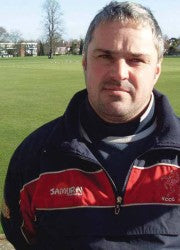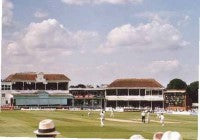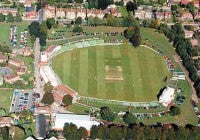The Garden of Cricket ...
 Most of the snow had been cleared from Kent County Cricket Club's Canterbury ground when I arrived. The only signs of the blanket of snow that had descended on this sporting corner of the south-east in early New Year were small mounds heaped up around the boundary.
Most of the snow had been cleared from Kent County Cricket Club's Canterbury ground when I arrived. The only signs of the blanket of snow that had descended on this sporting corner of the south-east in early New Year were small mounds heaped up around the boundary.
But, perversely, the white covering had simply served to throw up another problem for Head Groundsman, Andy Peirson.
Across the practice area in neat, broad columns was the tell-tale evidence of what had lain on the turf just a few days before - snow mould.
"The snow creates ideal conditions for it to thrive," Andy explains. "Temperatures rise under the snow so that the mould can quickly establish itself."
Andy had been quick to apply suitable fungicide to address the issue, warning me off the turf as I was about to take a closer look.
He had just returned from annual leave, escaping the icy blast of winter to discover that there was little he could do while the white stuff covered the green stuff.
But, standing in front of the Colin Cowdrey stand reminded me of Kent's glory days and the calibre of player that Kent could boast. The iconic St Lawrence Ground is the home of Kent Cricket, and all eyes and media attention will be on Kent in 2010 as they look to fight for trophies on three fronts: LV=County Championship; the Friends Provident Twenty20 Cup and the ECB 40L. As the club celebrates its return to the top flight, Andy predicts an exciting 2010, "Kent's young talent coming from the cricket academy with the established pros, Key, Jones, van Jaarsveld, Tredwell and the mix of new signings is really good for us."
 Gaining promotion last year, Kent is a club with growing aspirations. With a proposed multi-million pound redevelopment around the corner, the hope is to lift its current category C status up to a category B.
Gaining promotion last year, Kent is a club with growing aspirations. With a proposed multi-million pound redevelopment around the corner, the hope is to lift its current category C status up to a category B.
The redevelopment will see large-scale, multi-faceted refurbishment once the authorities and parties involved have "crossed the T's and dotted the I's" . The scheme involves part of the ground space being sold off to private developers, who will bring new housing and a luxury hotel to the site. The long term plan for the club being to recognise the need to develop as a facility, but to maintain the traditions that are dear to so many.
The £10m project is due for completion over the next two to three years in a phased programme. The housing and hotel building work were planned to begin two years ago but, due to the collapse of the property market and the original investors pulling out, the club were left seeking fresh sources of funding.
No-one is keener for Kent to meet those aspirations than Andy, himself an avid cricket enthusiast. When asked what he views as his key task here, he replies simply: "To present the best possible pitches I can, so that the players and coaches know they can rely on them and trust them."
Andy paints a straightforward picture, and couched in his reply is a desire to just do the job.
 He began his Kent career at Beckenham, working on the club's out ground, an extensive facility covering some twenty acres, and used for both first team Twenty20 cricket, women's fixtures and junior cricket.
He began his Kent career at Beckenham, working on the club's out ground, an extensive facility covering some twenty acres, and used for both first team Twenty20 cricket, women's fixtures and junior cricket.
He is now tasked with maintaining both the home pitch and the out ground, which includes five senior pitches, two mini pitches, a junior pitch, a synthetic pitch and two floodlit surfaces. Overseeing Kent's grounds keeps him and his small team of two full-timers fully occupied, he says.
His love of cricket is lifelong and led him, twenty years ago, to became involved in turfcare in Redcar, North Yorkshire - his accent betrays his origins. "I played loads of twenty over cricket while growing up in Yorkshire, so I had always wanted to be involved with the game in some shape or form," he reveals. "The short game was my early passion, which is why I'm such an advocate and fan of the Twenty20 format now," he continues.
He gained his first post at Redcar Cricket Club where he learned his trade, before moving on to fellow north-east clubs, Marske and Middlesbrough.
It wasn't until 2000 that he made his career-changing switch, moving to the south-east to join Ealing Cricket Club. "That was a huge culture shock for me, to move from the north-east to the heart of London," he confesses. "At one stage I nearly moved back up there, but I stuck it out and, since settling in, I haven't looked back."
As Kent look forward, anticipating outfield improvements at Canterbury to add to the leisure and housing expansion, Andy knows how critical it is for the playing surfaces to continue to improve, a responsibility he is relishing in his first full season at the club.
 "The only stipulation given to us by the team is simply to prepare the wicket to the best possible standard we can. It's essential that I liaise with the playing and coaching staff, and where I can inform them on playing conditions."
"The only stipulation given to us by the team is simply to prepare the wicket to the best possible standard we can. It's essential that I liaise with the playing and coaching staff, and where I can inform them on playing conditions."
"All in all, team relationships are strong at Kent, and they tend to let us get on with it and don't interfere too much with my job."
Kent captain Rob Key is sometimes seen as an outspoken figure, holding strong views on aspects of the game. Andy rejects that view though, maintaining that "in this job you have to speak your mind if you want your voice to be heard. One man's honest view is another's outburst, and I admire someone who is willing to speak their mind."
"As head groundsman, my voice is always strong," explains Andy, "but money is always the main factor to what gets done. My needs and the needs of the pitches always have to be weighed up against the whole site, as there are many different facets to the job. Maintaining a regular programme for the two sites is what I focus on," he adds.
The year-round maintenance programme usually starts the summer before the new season, so from September the team are already laying the groundwork for the following year. "We begin by selecting the wickets we want to use for the new season and prepare the net areas, removing any thatch and debris," he explains.
The square houses nineteen wickets, fifteen of which are used for first-class cricket. "We reseed and topdress with Binders Ongar loam, using a 100% ryegrass, which we've found to out-perform others we've tested, with very good recovery times."
 The secret to preparing good squares, believes Andy, is not to go for too fine a leaf. "There needs to be a good wear tolerance because, throughout the season, we place the grass under extreme stress, and then expect it to come back to life again quickly, so a hardy species is essential."
The secret to preparing good squares, believes Andy, is not to go for too fine a leaf. "There needs to be a good wear tolerance because, throughout the season, we place the grass under extreme stress, and then expect it to come back to life again quickly, so a hardy species is essential."
Dealing with the unpredictable seasons can throw up more problems for turfcare. Wind and rain are some of the worst factors to contend with, believes Andy. "The weather is generally getting wetter and windier, which can either be a good or a bad thing, depending on the season. If it's windy after heavy rain it has the benefit of being able to clear a lot of surface water from the pitch."
"In dry conditions it can damage the blade, so we have to be alert to these conditions," Andy cautions, before admitting that "there's little anyone can do to protect against the wind - it's a matter of laying good foundations so the elements don't get the upper hand."
Rolling the wicket at the right time is another one of Andy's keys to success - and finding the balance is a deciding factor, he says. "It's been proven that rolling for too long wears the life out of the turf. The thinking has been to roll and roll and roll, but ECB research from Cranfield University shows it just isn't the case."
"I like to prepare my wickets to a decent pace, not too quick but with a good bounce," he continues and is vehement in his belief that wickets "should always be prepared correctly, regardless of the fixture."
"I'm not in the business of setting up wickets to suit home advantage, or to the disadvantage of the opposition," he insists. "The wicket will usually be checked two days before the game by the manager and team captain, who will take instruction from the grounds team on how well they believe the wicket might play."
"It's around this time of year that we have our annual meetings to decide what needs to be done, and is the opportunity to talk more fully with the players and the manager to see what else they might want us to do, if anything."
Essential maintenance is "futile" without having the right tools for the job, he argues, which is why one of his next projects in the pipeline will be to reassess the club's turf machinery, possibly looking to update the stock from a sole supplier.
Harrogate Week and Saltex were once ideal opportunities for clubs such as Kent, looking to make big machinery replacements, to see what's on offer, yet Andy believes they no longer hold the same draw for visitors. "The major firms are much more flexible now and they're willing to come down and give demonstrations on site, which means you can see how they work on your turf, and all the team can trial them as well. The shows are also increasingly expensive, so I'm seeing less need to attend them."
Despite his wish to upgrade, Andy doesn't believe that old necessarily means bad. "I'm a big fan of some of the older pieces of kit, some of which we've had here for nearly thirty years," he says. The machines in the shed include a Ransomes Jacobsen Tri-King, for use predominantly on the outfields, two rollers and a Ransomes Mastiff which, despite being over thirty years old, "does a better job than many of the newer machines. The quality old machines are gold dust to come by and some models fetch big money."
 He uses a Paladin pedestrian walk behind mower, with groomer, for first preparing the wickets, while the Dennis FT610 cylinder mower and Ransomes Matador 61 help him maintain the nets area in winter.
He uses a Paladin pedestrian walk behind mower, with groomer, for first preparing the wickets, while the Dennis FT610 cylinder mower and Ransomes Matador 61 help him maintain the nets area in winter.
There's also a Ransomes Certes wicket cutter, a 4ft auto roller and two scarifiers - a SISIS 600 and SISIS Mach 4 - which Andy claims are "equivalent to the Graden model, but the Graden is quieter."
The club's bigger pieces of kit include a Cushman utility vehicle and a Valpadana tractor.
"I could do with an additional wicket mower, as it would ease the workload and reduce the strain on just the one machine," Andy adds.
Despite the antiquity of some machines, he remains happy with what he'd inherited. "Different groundsmen have different techniques and ways of doing things. You can't expect that you'll always inherit something that's just to your liking and that requires no improvements."
While Kent look towards the near future, with a view to rival the league leaders, the county's strong and vibrant academy and women's teams are thriving, thanks to structured investment in cricket.
The Kent Cricket Board, located on the Canterbury site, runs youth teams ranging from under-9s to under-17s, the latter a side that took the national league title for their age group last year.
Kent's women cricketers are also enjoying national success, retaining the championship title last year for the third successive year. Regulars include Lydia Greenaway and Charlotte Edwards, the latter being the captain of both Kent and England.
Andy is a strong advocate of the importance of developing the cricket 'buzz' at community level, as well as at the professional level.
As a member of the ECB's pitch advisory team, one of only three on the board in Kent, Andy has the opportunity to pass on some of his knowledge by working with local club groundsmen, giving them an insight into some of the techniques and practices used at a professional facility.
He is also active locally with cricket in Beckenham, after witnessing it go from strength to strength in recent years, thanks to programmes pushed by local enthusiasts to promote community cricket and help redevelop old disused grounds.
The aptly named Phoenix group works to source grounds, once actively used, and to restore them to a level suitable for community cricket. "Cricket is growing strongly in popularity among younger generations now, so its crucial for me to be active with schemes like this to raise awareness about careers in the sport and in groundsmanship, which often gets a bad reputation in the media with the stereotype of the job being that we 'just cut grass'."
"There's a serious lack of younger people coming into the job and a danger that, unless there's more of a focus, it will continue to be dominated by the older generation."
